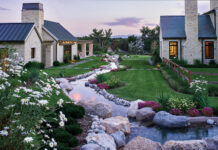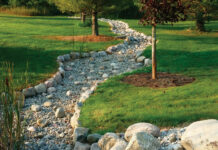Drainage solutions for water-logged properties.
Whether it’s a standalone project or integrated into a larger job, property drainage is an important, yet often overlooked aspect affecting most, if not all, properties.
With all the new construction taking place, topography is constantly being altered. This affects not only the property under construction, but usually has secondary consequences—including runoff and drainage issues—for surrounding properties as well.

Effective stormwater drainage systems either facilitate water flow to lower elevations or allow for corrective grading. Since each property is unique, I first perform a property evaluation to examine its available elevation, soil conditions, typical influx of water volume, and traffic. These factors affect the depth, diameter, thickness, and composition of the pipe that can be utilized. They also affect the type of soil separator and gravel that can be used.
Described below are details on several different property drainage solutions. I’ve also included a simple calculation used to determine the gallon capacity when estimating construction of a dry well.
Property Drainage Systems

Does the property have soggy areas or pooling during or after rains? These are typically the most common problems encountered. Poor drainage areas that result in these issues are typically best resolved by installing plastic drain boxes, cap surface drains, or larger capacity concrete catch basins with lift-off iron frame and grate. Appropriately sized underground drainage lines, usually PVC, are also installed, and connected to drain boxes or surface drains. These lines allow water to run downhill to a lower elevation.
Drainage lines can be installed in any size depending upon the anticipated waterflow on the property. For residential applications, 4″ diameter drainage lines are commonly used, whereas commercial applications require larger diameter drainage lines, with the size often determined by engineering specifications. (Due to the fact that every rain event is different, engineers’ calculations are hypothetical and should only be used as a guideline. For this reason, drainage systems can only be rated in how many gallons they can flow over a specified time frame, such as gallons per minute or hour.)
Larger diameter pipes are better in many cases, however, it’s important to note that a larger diameter line doesn’t always result in a better-flowing system. On properties where pitch is limited, a smaller diameter pipe may allow a slight advantage and more flexibility when every inch of elevation is critical. It can also flow better with reduced or eliminated sediment accumulation which results in better system performance and longevity.
Downspouts from the house or building may be tied into the drainage system along with sump pump ejection lines. A final task is to rake and seed the dug-up trenches, or in many cases, a sod cutter may be used to minimize turf damage on the property. Sidewalks, driveways, and curbs often need cutting and patching as well.
Grid Systems
Drainage grid systems are nothing new and have been successfully used in poor drainage areas, such as low-lying athletic fields, for many years. They are designed to absorb and redirect water below the surface with a series of underground lines and cap surface drains resembling a tic tac toe pattern. This grid is then attached to a solid PVC drainage line running to the street or a lower elevation. After install, the surface drains should be the only visible part of the system.
With over 30 years working in landscape drainage, I designed a drainage grid system that absorbs ground water below the surface in addition to draining away surface water. I achieved it by using perforated PVC surrounded by clean gravel and wrapped in filter fabric, instead of using solid PVC drainage lines only designed to carry water.

Dry Wells
In cases where a lower elevation is not available to drain to, or if required by the municipality where your job is located, installing a dry well is an alternative. Dry wells are designed to allow water percolation into the surrounding soil. In areas with high levels of soil saturation, however, it may take more time for absorption and the function of a dry well is highly dependent upon the water table. Outdoor sump pumps work well when used in conjunction with dry wells. (More on this later.) The dry wells I install consist of excavating a large hole, lining the hole with soil separator or filter fabric on all sides (including the top and bottom), and filling the hole with clean gravel. A drain box or catch is installed as an entry point to collect water. A property drainage system may be installed or modified to drain directly into the dry well.
Large capacity dry wells are effective, however once their capacity is reached, the dry well will overflow. For this reason, an overflow line should be installed if practical.
Here are two simple methods I use to calculate the gallon capacity of a dry well, dependent on stone size:
Example 1:
When using 2″ clean gravel, 65% of volume is available for water capacity.
A. Dry Well 8′ x 8′ x 3’6″= 224 cubic foot hole.
B. 224 cubic feet x 7.5 gallons per cubic foot = 1,680 gallons.
C. 1,680 gallons x .65 = 1,092 gallon capacity.
Example 2:
When using smaller ¾” washed stone, 55% of volume is available for water capacity.
A. Dry Well 8′ x 8′ x 3’6″ = 224 cubic foot hole.
B. 224 cubic feet x 7.5 gallons per cubic foot = 1,680 gallons.
C. 1,680 gallons x .55 = 924 gallon capacity
Clearly, the 2″ stone allows more water capacity since the spaces between stones are larger. Smaller ¾” stones can wedge closer to one another, which decreases water capacity.
Outdoor Sump Pumps & Catch Basins
On many properties, a lower elevation may not be available to drain water away. In these situations, an outdoor sump pump may be a good choice. Outdoor sump pumps are similar to those used indoors, however several safety measures should be built into the system. The pump itself should be built to industrial specifications to withstand freezing temperatures. Also, a weep hole may be installed between the pump and check valve inside the sump pit. Long runs pumping water uphill will require a larger, more powerful pump with greater diameter discharge line.
In combination with outdoor sump pumps, I recommend a concrete catch basin with iron frame and lift-off grate. This is because outdoor sump pumps require periodic maintenance. Sediment may need to be cleared away from the bottom of the pit and the pump intake kept clear. The frequency of this maintenance depends upon site conditions, but usually a good recommendation is every six to 12 months. Concrete catch basins provide a larger area for water and sediment accumulation and the lift-off grate allows easy accessibility. A plastic sump pump pit with interlocking lid may also be used as a low cost alternative.
Another thing to keep in mind with outdoor sump pump installation is that an electrician will need to be hired to wire the pump as required by local building codes. It’s also important to remember to always turn off electricity before doing any maintenance or cleaning the pit. The electric must also be shut off during cold temperatures to prevent the pump from burning out.

Fidlow is owner of RF Landscape Construction and Yard Drainage in Scotch Plains, NJ, and has over 30 years experience in constructing drainage systems.
Click here to read more about stormwater management in the lawn care and landscaping industry.



Do you have a comment? Share your thoughts in the Comments section below, or send an e-mail to the Editor at cmenapace@groupc.com.











![[VIDEO] Dickies®: Discover Workwear That’s Anything But Uniform](https://turfmagazine.com/wp-content/uploads/2023/06/1647663814-4b1a2a7742790a9b1e97a3b963477850192e1d6a9dfba9b07214a77bae25d6e3-d-218x150.jpg)






























![[VIDEO] Dickies®: Discover Workwear That’s Anything But Uniform](https://turfmagazine.com/wp-content/uploads/2023/06/1647663814-4b1a2a7742790a9b1e97a3b963477850192e1d6a9dfba9b07214a77bae25d6e3-d-324x160.jpg)
The article fails to address soft solutions such as rain gardens and permeable pavements that are successful alternatives depending on soils. The use of pipes to convey to a low elevation just moves the rainwater to another location which does impact that area thus not providing a sustainable solution. Poor planning and alteration of topography to make development is a primary contributor along with compaction of soils and use of way too much hardscapes just makes mitigation of rainwater that much more problematic. By the way a little bit of ponding that dissipates is not terrible thing but due to “societal expectations” that somehow is viewed as a negative. As long as the water precs or evaporates within 72 hours all is good.
Hi Imants, Thanks for your comment! I completely agree that rain gardens and permeable hardscape are great solutions to drainage issues. This article was meant to represent one part of the puzzle for those sites where “soft solutions” might not be adequate on their own. A combination of site-specific strategies is naturally ideal.